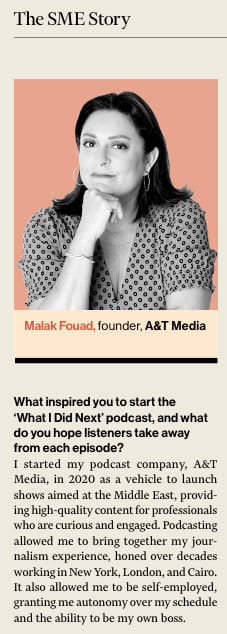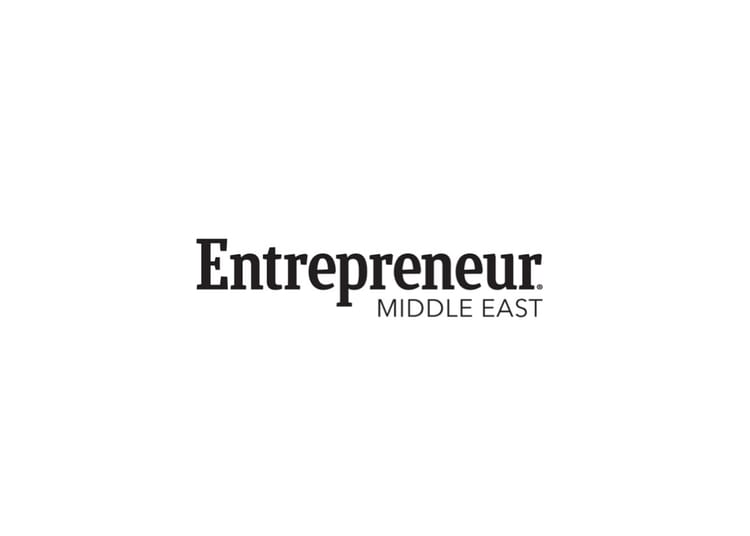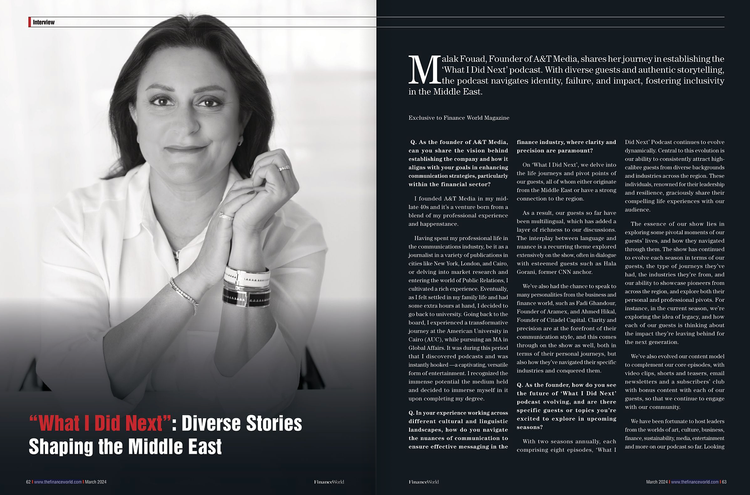Communicate: The Power of Audio in Driving Commerce

Communicate spoke to Malak Fouad on podcast commerce & how brands can better leverage audio advertising:
Audio is a very cost-effective way of reaching your audience, you can start small with a few episodes across multiple shows, and go big with collaborations and season or annual buys. It’s important to focus on podcasts that fit your brand ethos, have the right target audience, and look to tie-in with key marketing initiatives you’re already doing as a brand to create multiple touch-points.
Read the full Q&A ↓
What initially drew you to the world of podcasting and audio communication as a professional?
Podcasting was a ‘sum of all parts’ for me in that it allowed me to harness all the experience I had gathered over decades in the communications industry, and share our region’s stories with a captive audience. Having worked as a journalist in New, London and Cairo and in media consultancy and PR in London and Cairo, I felt I could bring the 360 vision and know-how to creating an audio content company. I had just finished a Masters and felt the time was right to jump into this new and exciting medium.
As a communications professional, how do you perceive the unique advantages of audio advertising compared to other mediums, especially in the context of driving commerce?
The direct contact with the audience is unique and the fact that the listening happens on-demand means that the audience is already predisposed to hearing curated advertising content. Audio is also great in that you can consume while continuing with your day, whether while commuting, working out or running errands for example. The key is making sure the advertiser is a ‘match’ with our target audience, and the brand of the show as well.
Can you share a specific example where audio advertising significantly impacted a brand's success in driving purchases or converting consumers into long-term customers?
One of the premiere examples of this is Squarespace, who have run podcast ads since 2009, and found a third of new subscriptions came from the campaign. By 2015, they had spent 2.5x more than the second-highest advertiser, creating a fan following of long-term customers and evangelists for the platform. We’re seeing a similar scale-up in the region as well. EFG Holding for example, have expanded their partnership with What I Did Next since starting on Season 2. We’ve also seen other global brands enter the podcasting world in the region, such as Mastercard’s partnership with Forward Talks, and the Tim Hortons collaboration with The Mo Show.
In your experience, what are some common misconceptions brands have about the effectiveness of audio advertising in driving commerce?
Like with any industry in its nascent stage, podcasting in MENA is still evolving. One of the main issues is education marketing and communication departments about the benefits of audio for their brand. One of the many misconceptions is the size of the podcast and audio markets, and the fact that audio is one of the most effective ways in terms of brand uplift, brand retention, and brand action.
What role does storytelling play in creating effective audio ads for brands? Can you provide an example of a compelling audio ad campaign that utilized storytelling to drive commerce success?
Creating compelling ads through storytelling is as important in podcasting as it is for all mediums. Last season for example, we did a special sponsored episode with our long-time partner EFG Holding through interviews with 2 C-suite executives. This allowed us to create awareness for the brand, and their values in a way that is inkeeping with the format of our show and making it easy for the audience to immerse themselves. This also helps us create a smooth transition within our regular episodes, where the experience of listening to an ad or a sponsor message is not jarring as it is in other mediums.
With the rise of podcasts and streaming platforms, how do you see the landscape of audio advertising evolving in the next 5 years, particularly in the Middle East region?
We’re still in a nascent phase of the industry in the Middle East, so we will still see a lot more content across more categories which will also help expand the advertising landscape. Technology partnerships with podcasts and ad platforms as well as other integrations means more brands are being onboarded into the podcast ad world as we speak. We expect the region will rival the US market cap and be a major global player for podcast content and advertising over the next 5 years.
Metrics are crucial for advertisers to gauge the success of their campaigns. What key metrics should brands focus on when evaluating the effectiveness of their audio advertising efforts?
The on-demand nature of podcasts means that the number of ad impressions is an effective metric of knowing your audience has heard your message. Modern podcast and ad platforms also provide you with unique listener estimates against your impressions, regional and demographic data. Brands with physical products can also use specific campaign codes to track effectiveness. At A&T Media, we also couple this with social media as well as our newsletter metrics to provide a well-rounded overview of our partner ad campaigns.
How can smaller brands or retailers with limited resources effectively leverage audio advertising to compete with larger players in the market?
Audio is a very cost-effective way of reaching your audience, you can start small with a few episodes across multiple shows, and go big with collaborations and season or annual buys. The on-demand nature of podcasts means that your audience is already open to your message, and you can work closely with creators to tailor your message to their audience. It’s important to focus on podcasts that fit your brand ethos, have the right target audience, and look to tie-in with key marketing initiatives you’re already doing as a brand to create multiple touch-points.
Personalization is a growing trend in marketing. How can brands effectively personalize their audio ads to resonate with diverse audiences and drive commerce success?
With a lower production cost compared to other mediums, the ability to target separate territories and countries, or separate devices with customised messages means there’s a lot you can do to personalise your audio ads. We work very closely with our brand partners so that their messages are crafted into bespoke campaigns that can change during our season runs, and recommend coupling this with social media platform targeting with your podcast partner to help drive success.
When it comes to consumer behavior, what insights have you gathered about how audio advertisements influence purchasing decisions, especially in a region like the Middle East?
We see the Middle East as a region with a dedicated audience who are eager for new content, especially one that showcases the region, its heritage and culture, and its stories. This is also great for brands who want to tap into the region’s audience and showcase their product or service through creative collaborations and storytelling. Today, we’ve developed a loyal audience that is excited to hear from our brand partners as well. For example, during our last season campaign with EFG Holding, our sponsor-dedicated newsletter saw an open-rate that was at par with our regular episodes.
In your opinion, what are some of the challenges brands face when trying to integrate audio advertising into their overall marketing strategy, and how can they overcome these challenges?
As I’ve mentioned, awareness is definitely a challenge we see today, a one-size-fits-all approach does not always work for audio, or even video shows. Being a newer medium in terms of going mainstream, brands also tend to think only in terms of social media metrics vs utilizing the full gamut of what podcasts can do–from episode and show-level campaigns to sponsor collaborations, product placement and more. Podcasts being decentralized as a medium has great advantages, but it also has an impact on integrating technology with ad platforms that have been traditionally used by ad buyers, although there has been some program here in recent years.
Lastly, what advice would you give to brands and retailers looking to embark on an audio advertising strategy to drive commerce success, based on your expertise and experience in this field?
Podcasts are extremely flexible in terms of the types of campaigns we can run with brands, from pure ad-buys to long-term sponsor collaborations, as well as product placements and integrations. Brands often look at podcasts as a separate campaign from their existing marketing and communications initiatives, and integrating these creates a coherent marketing strategy with multiple touch-points that are very effective in driving your message. Our advice to brands would be to test the waters, start small and scale up, which is incredibly easy to do with podcasts.
Like these stories? You will (probably) love our weekly newsletter.






Member discussion